2025 Calendar Photo Contest! Enter Now

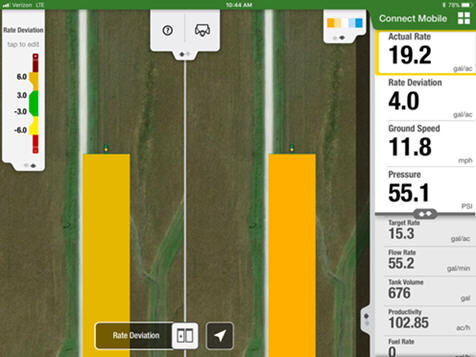 Connect Mobile showing a singulation map and monitoring planter performance
Connect Mobile showing a singulation map and monitoring planter performanceJohn Deere Connect Mobile is a solution that utilizes an Apple® iPad® in the cab that provides the operator a better understanding of the planter’s performance. Connect Mobile documents and displays the row-by-row performance of the planter, helping the operator monitor and more easily detect problems that can occur while planting. Connect Mobile also has a common user interface that makes it easy to use between different pieces of John Deere equipment. Once the job is done, the iPad with the planting data can be utilized to perform basic crop scouting activities in the field.
Monitor and document key performance indicators in high-definition map layers and dashboard tiles such as:
Connect Mobile hardware is factory installed on all model year 2015 and newer planters factory installed with ExactEmerge™ row-units and all model year 2017 and newer planters factory installed with MaxEmerge™ 5e row-units, making it easy to get started with Connect Mobile.
Learn more about Connect Mobile in the Field and Crop Solutions section within the Precision Ag Technology product line and how it can improve the quality of a planting job.
iPad and Apple are trademarks of Apple Inc.
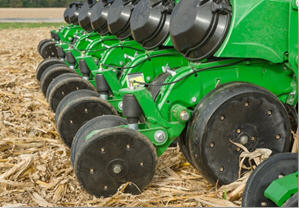
Pneumatic closing wheels are compatible with MaxEmerge 5e and ExactEmerge™ row-units. They are available on the following models from the factory: 1775NT, 1795, and DB 60 models, the pneumatic closing wheels give producers the ability to adjust closing wheels in seconds without leaving the cab of the tractor.
Using the GreenStar™ 3 2630 Display, pneumatic closing wheels can be adjusted to 25 different positions. From the factory the system is setup with two sections, the outer wings and center frame. With this system, producers will see up to a 76 percent increase in consistent force applied at the closing wheel. Consistently applying the correct force at the seed trench is one of the key elements of supporting improved emergence. Studies show potential yield impact on corn from even emergence from 5 percent to 9 percent*.
NOTE: Pneumatic closing wheels can be purchased for existing MaxEmerge 5e and ExactEmerge planters as an aftermarket field kit. Both rubber tire and cast-iron closing wheels are compatible.
Access the pneumatic closing wheels AFC ordering guide to fit your 1725 CCS, 1775NT, 1795, or DB60 planter.
*Planting Outcome Effects on Corn Yield: Doerge, Tom, Jeschke, Mark and Carter, Paul
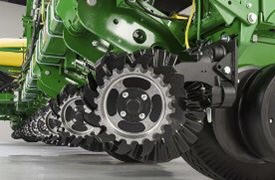 Coulter Combo row cleaner
Coulter Combo row cleaner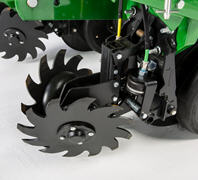 Easy Adjust row cleaner
Easy Adjust row cleanerEasy Adjust row cleaner and coulter combo provides a pneumatic row tillage solution that is controlled from the seat of the tractor.
Every decision to make an adjustment during spring planting reduces the acres planted per day and can increase or decrease profitability. An adjustment that can be overlooked is row cleaners due to planter size, difficulty to make the adjustment, varying conditions across fields and time.
 GreenStar™ 3 2630 Display view for Row Cleaners compatibile with SeedStar™ 3HP
GreenStar™ 3 2630 Display view for Row Cleaners compatibile with SeedStar™ 3HP 4600 CommandCenter™ and 4640 Universal Display view for Row Cleaners compatible with SeedStar 4HP
4600 CommandCenter™ and 4640 Universal Display view for Row Cleaners compatible with SeedStar 4HPWith the Easy Adjust row cleaners on ExactEmerge™ planters, operators now have a pneumatic solution to make on-the-go adjustments that is controlled directly from the seat of the cab. They can be raised from the cab as needed with the push of a button for wet areas, waterways, or end rows. For growers using SeedStar 3HP, the row cleaners are completely integrated into the John Deere GreenStar 3 2630 Display as well as the Gen 4 4600 CommandCenter or 4640 Universal display. For growers using SeedStar 4HP a 4600 CommandCenter or 4640 Universal Display is required.
The Easy Adjust row cleaners have the capability to save three presets for varying ground engagement based on field conditions. The system is controlled in three sections, each wing as well as the center (frame or wheel) track rows. The pneumatic lines use air from the active pneumatic downforce compressor requiring no additional compressor to be installed on the planter. The Easy Adjust row cleaners utilize down and up force air bags. The adjustable air pressure setting for each bag allows the operator to set the ride of the row cleaner depending on the field conditions and the desired results. Making these on-the-go adjustments from tractor cab increases productivity and performance during planting.
For Easy Adjust Row Cleaner retrofit kit options, see the ordering guide.
The row cleaner only option utilizes parallel linkage to provide the floating action growers require in their fields. Parallel linkage allows for the unit to float up and down in the situation of hills or hard objects. The cleaner and coulter combo does not have parallel linkage, however, the row cleaners have floating rings installed to help provide the same benefits.
The row cleaners utilize the field-proven SharkTooth® design. Row cleaners play a major role in maximizing yield toward uniform emergence, reducing row-unit bounce and maintaining proper depth. The easy-adjust row cleaners provide growers with quick and stress-free solutions to customizing the planter in variable field conditions. Easy Adjust row cleaners are available on ExactEmerge and MaxEmerge 5e equipped planters. The Easy Adjust row cleaners are not integrated into RowCommand™ feature.
SharkTooth is a trademark of Yetter Manufacturing Incorporated.
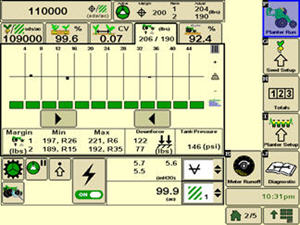 SeedStar 3 HP shown on the GreenStar™ 3 (GS3) 2630 Display
SeedStar 3 HP shown on the GreenStar™ 3 (GS3) 2630 Display
Building upon the foundation of previous SeedStar monitoring, the SeedStar 3 HP monitoring system takes planter monitoring to the next level. When paired with the GS3 2630 Display, the SeedStar 3 HP monitoring system provides critical information about the planting process to the operator within the tractor cab. SeedStar 3 HP is compatible with the GS3 2630, the Gen 4 4600 CommandCenter™ and 4640 Universal display.
Detailed planter performance information allows the operator to make adjustments needed for planter optimization. After all, with rising costs, it is imperative to make sure that every seed is planted accurately and precisely within the seed furrow for maximum yield potential.
The SeedStar 3 HP planting functions are fully integrated with the full spectrum of AMS applications such as John Deere Section Control for Planters, GreenStar (GS), AutoTrac™ assisted steering system, John Deere Operations Center, JDLink™ telematics system, and others. Integrated planting technologies, for better asset utilization and ease of use, is just part of what SeedStar 3 HP provides.
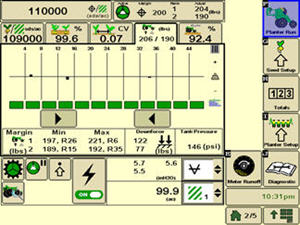 SeedStar 3 HP main run page
SeedStar 3 HP main run pageSeedStar 3 HP has an updated main run page layout. With the use of tabs toward the top of the screen it is much easier to navigate through readings such as population, singulation, spacing, downforce, and ride quality. If for some reason an issue arises with a row-unit, the tab will turn red indicating there is an issue. The tab can be pushed and lead to what is causing the issue. Inside each tab, there will be a bar graph detailing information specific to that tab. The picture shows what a population bar graph looks like. This layout improves functionality and overall ease of use while planting.
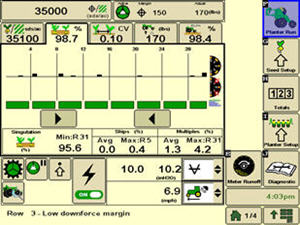 SeedStar 3 HP seed singulation planter run page
SeedStar 3 HP seed singulation planter run pageUnderstanding meter singulation performance on the planter is critical to minimizing the amount of seed multiples and skips. As a result, the SeedStar 3 HP monitoring system provides real-time information, from the redesigned seed sensors placed in each belt cartridge, about the overall seed singulation performance.
As seen in the screen shot image to the left, overall singulation performance is seen in the tab at the top of the screen. Seed skip and multiple sources of information are displayed below the bar graph of the run page. This provides the operator a better understanding of relative seed multiple and skip data on a row-unit basis within one easy glance at this run page.
Also, within the seed singulation planter run page, information about row units with the highest percentage of seed multiples and skips is provided in order to make necessary adjustments for better planter optimization.
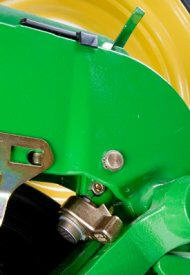
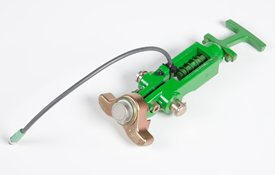
Depending on the planter size, different configurations of sensor nodes and downforce sensors are installed in support of the SeedStar 3 HP monitoring system.
SeedStar 3 HP is only available with the MaxEmerge 5e and ExactEmerge™ row-unit compatible planters built prior to model year 2018.
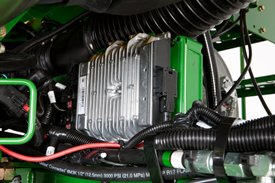 Planter main controller
Planter main controller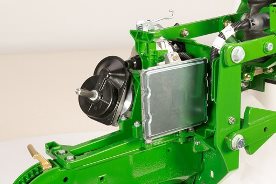 Row-unit controller (RUC) with two electric motors
Row-unit controller (RUC) with two electric motorsThe SeedStar 3 HP monitoring system contains the following components in order to support the planting data transfer to the GS Displays:
The row-unit controller processes the row-unit data from the sensor node assemblies located on the row-unit head casting. The processed information is then sent to the planter main controller to be integrated into the displayed information being sent to the GS Display.
Downforce sensor assemblies are found on row units with sensor nodes installed. The downforce sensor assembly is put together with the gauge wheel depth-adjustment handle and provides gauge wheel pressure information to the respective sensor node for data processing.
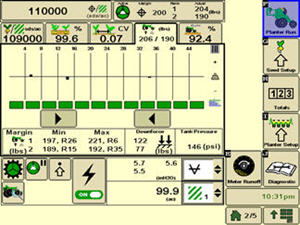 SeedStar 3 HP downforce planter run page
SeedStar 3 HP downforce planter run pageWith changing field conditions, it is important to monitor down force to ensure consistent seed placement. Seeds placed too shallow or too deep can impact emergence and affect yield.
With the SeedStar 3 HP monitoring system, row-unit downforce information is measured by the down force sensor and sensor nodes and transmitted to the GS Display in the tractor cab. The row-unit down force information is displayed on the top portion of this run page with more row-unit down force information on the lower portion.
Active pneumatic down force takes SeedStar 3 HP even further by removing constant down force adjustments from the operator and actively controlling the downforce system to maintain a desired target margin. Just set the row-unit target margin value and the active pneumatic downforce system works automatically to make sure the planter maintains this value-achieving precise soil penetration, and consistent planting depth, without sidewall soil compaction. This frees the operator from constantly making manual downforce adjustments as conditions change.
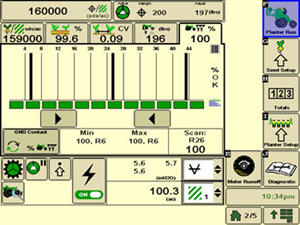 SeedStar 3 HP ride quality and ground contact run page
SeedStar 3 HP ride quality and ground contact run pageThe fifth tab from the left in SeedStar 3 HP is a shared tab between ground contact and ride quality. Operators may change between the two criteria based on their planter setups or personal preferences. Ground contact displays the percentage of time the row-units are engaging the ground, the load is measured via a sensor through the gauge wheels. Ground contact is recommended when using ExactEmerge row units to ensure the row-unit is maintaining proper depth at higher planting speeds.
 SeedStar 3 HP seed spacing planter run page
SeedStar 3 HP seed spacing planter run pageThroughout the planting process, obtaining good seed spacing is critical towards achieving plant growing conditions for maximum yield potential.
Today, many items are adjusted on the planter prior to planting to optimize overall seed spacing performance. But after such adjustments are made, information about the actual seed spacing performance during planting was missing within the planter monitoring system. Now with SeedStar 3 HP, seed spacing information is transmitted live via the GS Display to show the operator exactly what is happening with the planter behind them.
The SeedStar 3 HP transmits seed spacing information onto the bar graph (shown to the left) for easy understanding of planter seed spacing performance. Also, information about seed skips and multiples are provided to help understand actual planter meter performance and other related system functions in order to make necessary adjustments if needed.
 SeedStar 3 HP runoff page
SeedStar 3 HP runoff pageOn SeedStar 3 HP, the meter runoff page allows growers to test meters before going to the field. Growers can now test the meters without removing them and have confidence in your planter’s performance before going to the field. Many parameters are able to be viewed during this test such as: singulation, seed count, skips, multiples, coefficient of variation (cv), etc. This test assures that the meter is in healthy condition and ready to plant when conditions are appropriate.
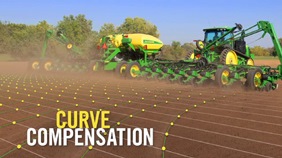
Terraces or waterways are two of many field obstacles that make planting on a curve challenging. When planters utilize drive shafts, they are not able to control each individual row-unit; as a result, planting on a curve presents an issue of maintaining 100 percent population. Since the inside rows are moving slower than the outside rows, the inside rows will be over populating while the outside rows are under populating.
With ExactEmerge™ Planters and equipped MaxEmerge™ 5e Planters, the curve compensation feature allows each row to receive an individual signal based on the speed the row-unit is moving, maintaining the correct population across the width of the planter. Without curve compensation, there could be as much as a 24 percent drop in population accuracy, which is equivalent to 8,600 seeds per acre when planting at 36,000 seeds per acre. Curve compensation measures acceleration within the main planter controller and utilizes speed inputs to ensure each row has desired population accuracy.
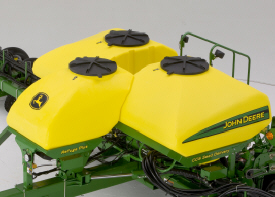
DB44, DB60, DB60T, DB66, DB80, DB88, DB90, and DB120 Planters can be equipped with the Refuge Plus option from the factory.
The third tank on the Refuge Plus system provides increased versatility and productivity to the planting operation by allowing the grower to plant two different varieties simultaneously. The Refuge Plus tank has manifold nozzles, or outlets, to supply seed to eight different row-units.
Refuge Plus is ideal for the grower planting Bt corn or seed corn. Refuge Plus is the solution for refuge management compliance issues associated with Bt corn production. The 880-L (25-bu) capacity of the third tank makes planting the required 20 percent refuge of non-Bt corn easier while maintaining high productivity levels of the central-fill CCS.
For example, Bt corn planted on 80 percent of the field goes into the larger CCS tanks. The required 20 percent refuge, non-Bt corn, goes into the third Refuge Plus tank with the seed hoses routed to the desired rows.
Central fill with CCS is easier for the seed-corn grower as well. The seed-corn grower can plant both male and female seed in the desired pattern simply by placing the male seed in the Refuge Plus tank, the female seed in the CCS tanks, and routing the seed delivery hoses to the desired row units.
NOTE: Only DB44, DB60, DB60T, DB66, DB80, DB88, DB90, and DB120 Planters can be equipped with the Refuge Plus option from the factory. Other CCS equipped models can add Refuge Plus through parts.
 Seed delivery hose connection and yellow plug
Seed delivery hose connection and yellow plugRedirecting seed delivery from the CCS tanks to the Refuge Plus tank is fast and easy with quick-disconnect couplers. By simply disconnecting the desired CCS delivery hoses from beneath the CCS tank, capping those hoses and reconnecting the delivery lines to the Refuge Plus tank, the seed delivery source is changed.
Due to the additional weight Refuge Plus places on the planter frame, liquid fertilizer tanks are not compatible. Updated liquid insecticide tank codes have been established for Refuge Plus planters.
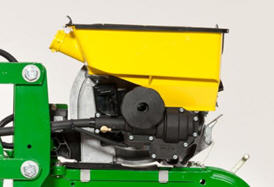 RowCommand on a MaxEmerge™ 5 row-unit
RowCommand on a MaxEmerge™ 5 row-unit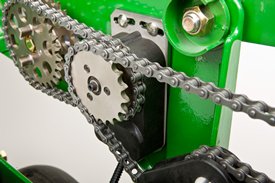 RowCommand on a chain drive MaxEmerge 5 row-unit
RowCommand on a chain drive MaxEmerge 5 row-unitControlling input costs and improving productivity are key producer requirements today. RowCommand is an effective, integrated John Deere solution designed to meet these intensifying needs. The RowCommand system manages seed output, reduces yield drag, and improves harvest capabilities on all Pro-Shaft™ driven row-units, and chain-driven MaxEmerge 5.
NOTE: Chain-drive RowCommand is only compatible with planters equipped with pneumatic downforce systems. On planters equipped with the heavy-duty downforce springs, potential chain interference may result and is not recommended.
NOTE: Chain-drive RowCommand requires some modification to brackets in order to function with corn finger pickup meters.
NOTE: Pro-Shaft drive RowCommand is compatible on MaxEmerge 5 row-units with vacuum and corn finger pickup meters. For mini hopper row-units, RowCommand is compatible on vacuum meters only and is not compatible on corn finger pickup meters. Pro-Series XP row-units with corn finger pickup meters are not compatible with RowCommand.
RowCommand controls seed output by incorporating individual, low amperage clutches inside the Pro-Shaft and chain-driven gearboxes. Clutches are completely enclosed within the gearbox housing to protect them from the elements and harsh operating conditions.
When power is supplied, either manually or through John Deere Section Control software, clutches disengage the seed meters and seed flow stops. Controlling seed output at individual rows reduces overplanting in point rows and maximizes seed placement when entering/exiting headlands.
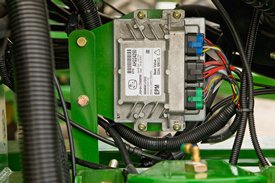 EPMs shown on a 1775 NT Planter
EPMs shown on a 1775 NT Planter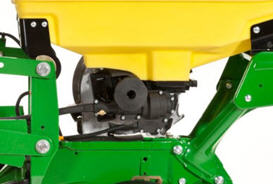 RowCommand clutch on MaxEmerge 5 with 3-bu hopper
RowCommand clutch on MaxEmerge 5 with 3-bu hopperRowCommand is a simple and efficient solution to control individual row planting. This system does not utilize air to operate; therefore, no compressor, air lines, or valve modules are required.
RowCommand utilizes low-voltage controller area network (CAN) messaging to signal power to the desired clutches to stop planting or eliminates power to resume planting.
This means very little power is used in normal planting conditions, and in the event a clutch fails electrically, the meter will continue to plant.
To add RowCommand to a model year 2009 and newer planter model listed above is simple. Pro-Shaft drive attachments for field conversion and chain drive attachments for field conversion are available by planter model to add the appropriate number of clutches, EPMs, brackets, hardware and row-unit harnesses. For complete installation and part detail for the RowCommand conversion, please use the RowCommand compatibility tool per specific planter model.
RowCommand is compatible and available for model year 2003 (serial number 700101) to 2008 (725101) planter models listed above. In addition to the attachment for field conversion attachment, a planter mainframe harness, SeedStar 2 controller (wedge box), and additional CAN harnesses are needed.
The RowCommand system requires the following five basic components to operate:
Clutches are protected within the sealed Pro-Shaft and chain-driven gearboxes for years of trouble-free operation and simple installation or removal. RowCommand has true individual-row control of up to 16 clutches or sections for planters larger than 16 rows.
Unique to RowCommand, the 16 available control sections can be configured based on operator preferences. For example, on a 1775 NT 24-Row Planter, every two rows can be paired together for a total of 12 control sections, or control the outermost eight rows individually and the remaining inner rows paired together for 16 control sections.
While SeedStar with RowCommand has 16 control sections, a minimum of 152-cm (60-in.) wide sections are recommended for optimum Swath Control Pro™ solution capabilities. As with other Swath Control Pro products, a SF 2 signal is the minimum level of accuracy recommend for operation.
RowCommand is available as a factory-installed option or as an attachment for field conversion attachments for the following Pro-Shaft drive planter models (see chart below).
| Planter model | Row configuration |
| 1725 | 12-row narrow, 12-row wide, and 16-row narrow |
| 1725 CCS™ | 16-row narrow |
| 1765 | 12-row narrow |
| 1775 | 12-row narrow |
| 1775NT | 12 row, 16 row, and 24-row narrow |
| 1775NT CCS | 12 row, 16 row, and 24-row narrow |
| 1795 | 12/23 row, 12/24 row, 16/31 row, and 16/32 row |
| 1795 | 24 row, 50 cm (20 in.) |
| DB 44 | 24 row, 56 cm (22 in.) |
| DB 58 | 32 row, 56 cm (22 in.) |
| DB 60 | 36 row, 50 cm (20 in.) or 47 row, 38 cm (15 in.) |
| DB 66 | 36 row, 56 cm (22 in.) |
| DB 80 | 32 row, 76 cm (30 in.) or 48 row, 50 cm (20 in.) |
| DB 88 | 48 row, 56 cm (22 in.) |
| DB 90 | 36 row, 76 cm (30 in.) |
| DB 120 | 48 row, 76 cm (30 in.) |
| DR (Deere/Orthman™ planter) 16R40 | 16 row, 102 cm (40 in.) |
| DR (Deere/Orthman) 18R38 | 18 row, 97 cm (38 in.) |
In terms of planter compatibility, RowCommand for chain drive is designed for the following planter model configurations equipped with pneumatic downforce systems.
| Planter model | Row configuration |
| 1725 | 12-row narrow, 12-row wide, and 16-row narrow |
| 1765 | 12-row narrow |
| 1775 | 12-row narrow |
| 1775NT | 12 row and 16 row |
| 1775NT CCS | 12 row and 16 row |
| DB 44 | 24 row, 56 cm (22 in.) |
 Chain interference with heavy-duty downforce
Chain interference with heavy-duty downforceAs seen in the picture, chain interference may result when operating chain-drive RowCommand on planters equipped with short and long parallel arms and heavy-duty downforce springs.
NOTE: Chain-drive RowCommand is only compatible with planters equipped with pneumatic downforce systems. On planters equipped with the heavy-duty downforce springs, potential chain interference may result and is not recommended.
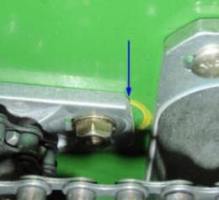 Bracket material removal
Bracket material removalDue to the design characteristics of the chain drive RowCommand clutch, some modification to the corn finger pickup meter drive bracket is required. As seen in the picture to the left, some material needs to be removed from the front of the meter drive bracket in order for the chain-drive RowCommand clutch to have sufficient space for installation.
NOTE: Chain drive RowCommand requires some modification to brackets in order to function with corn finger pickup meters.
RowCommand is a simple and efficient means to control individual row planting through the use of low-voltage electric clutches. When activated, each clutch consumes no more than 0.5 amps. By design, power is only supplied to the clutch when a signal is received to stop planting. In a normal planting condition, no power is supplied and the clutch is de-energized.
Power for the RowCommand system is provided from the 9-pin ISO implement connector. All late-model 8X00 and 9X00 Series John Deere Tractors equipped with the 9-pin ISO implement connector are capable of supplying ample power for system operation.
Along with ample system power, a GreenStar display and SeedStar monitoring are required for operation and control interface. The GreenStar display is where system setup, control settings, and manual control functions are performed.
Coupling RowCommand with Swath Control Pro provides the ultimate in precision planting and productivity. One company, one integrated solution are what we offer by incorporating Swath Control Pro capabilities within the SeedStar 2 wedge box (controller). Unlike previous systems, no rate controller, additional harnessing, or components are required to achieve automated individual-row control.
SeedStar 2 monitoring, RowCommand, and Swath Control Pro activation from John Deere Precision Ag Technologies are all that is needed when ordering.
Option code 2627 contains a ground-driven pump, plumbing to a manifold, and routing to each row-unit. The row-unit routing allows for fertilizer delivery in front of the seed, or seed tube. Option code 2627 is not compatible with ExactEmerge™ planters because it would place fertilizer in front of the BrushBelt™ system.
Option code 2628 contains a ground-driven pump plumbing to manifold and plumbing to each row-unit with a coil of hose. This option code requires either dealer or operator installation of fertilizer delivery components, such as BA32912.
Option code 2629 includes a ground-drive frame and tire with drive sprocket. This option does not include a pump, manifold, or fertilizer delivery components.
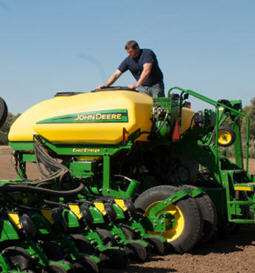 CCS
CCS
CCS seed delivery adds productivity through increased seed capacity, bulk fill capability, and easy, thorough cleanout.
The two tanks have a combined capacity of 2470 L (70 bu) on 9-m (30-ft) planters and 3520 L (100 bu) on 12-m (40-ft) and larger planters. CCS tanks are manufactured using a rotomolded, polyethylene design to ensure maximum durability. The translucent tanks allow easily viewing the amount of seed in the tanks. The tanks are separated by 55 cm (21.5 in.) for enhanced rear visibility during transport and backing.
The following crops can be planted with CCS: corn, sweet corn, popcorn, cotton, sunflowers, sugar beets, soybeans, and sorghum (milo).
Filling the tanks is convenient due to a central filling location. The staircase and railing provide access to the filling platform between the tanks. If filling the tanks with an auger, minimum recommendations are a 15-cm (6-in.) diameter, 4.3-m (14-ft) auger. Each tank has an adjustable, bin-level sensor to alert the operator when it is time to fill.
A standard fill light package is available on machines equipped with CCS. This feature includes two lights conveniently mounted on the railings of the machine. The lights are turned on and off with their own switch located at the bottom of the staircase.
If the seed-carrying vehicle requires hydraulic power to run the unloading system, the auxiliary hydraulic coupler option is available. These couplers are located at the bottom of the staircase and can be coupled under pressure. The system has a separate system filter that ensures your planter hydraulic system remains free of contaminates.
CCS is about reducing the time spent filling the planter with seed while maximizing the time spent planting. CCS for planters is a form of seed handling and delivery. The row-units perform the final task of seed metering and placement.
The CCS seed delivery process relies on a hydraulically-driven fan to move seed from the CCS tanks to the row-units. This fan is plumbed in to the planter's raise/lower circuit, so only one selective control valve (SCV) is needed for both functions. When the planter is lowered, lift cylinders bottom out and hydraulic flow is diverted to the seed delivery fan. A flow control valve and gauge, located near the tank, allows for the proper tank pressure setting based on seed type.
Air from the fan pressurizes the CCS tanks and delivers seed to the seed hoppers. Airflow enters the seed tanks through a nozzle in the manifold which pressurizes the tank. The air then picks up seed and moves out the other end of the nozzle into seed delivery hoses. These hoses route the seed toward the hopper. A small amount of seed is traveling in the delivery hoses only when needed.
The hopper fills with seed until the delivery hose (discharge elbow) is covered. Once the opening is restricted, seed flow through the hose stops. Air flowing to the row unit travels into the hopper and is the source of air for the vacuum system. This provides a much cleaner air source than previous meter designs. As the seed is picked up by the meter and planted, the seed pool shrinks until the end of the delivery hose is uncovered. At that time, the airflow and seed delivery resume and the seed pool in the hopper is replenished.
Seed cleanout could not be much easier with a CCS Planter. When finished planting, any remaining seed can simply be removed via access doors at the bottom of the CCS tank.
Because seed is only traveling through the CCS delivery hoses when required by the meter, there is not much left to clean.
Next, CCS seed delivery hoses are then purged with air from the CCS fan and the excess seed is pushed to the individual meters.
The vacuum meter door is opened and seed is removed with the supplied catch pan.
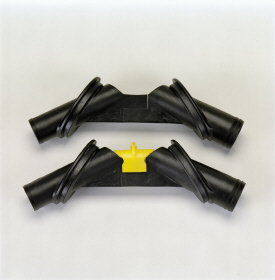 Manifold nozzle and nozzle with cover installed
Manifold nozzle and nozzle with cover installed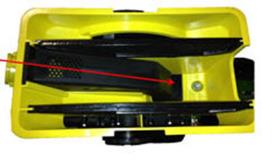 Straight-seed inlet installed in mini hopper
Straight-seed inlet installed in mini hopperCCS seed delivery system increases planting productivity across the seven approved crops listed above. While highly effective delivering seed from the CCS tanks to the vacuum meters, small or light seeds (sorghum and small cotton) will require two additional components to aid in proper seed delivery.
Manifold nozzle covers (clips) should be installed to ensure seed is adequately picked up into the air stream for delivery to the row-unit. Mini-hopper discharge elbows should also be changed from the standard elbow (holes) to the small seed elbow (slotted openings) when planting sorghum (milo) and small cotton.
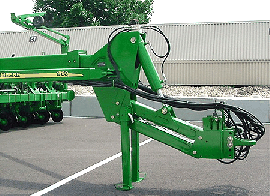 Drawbar hitch
Drawbar hitch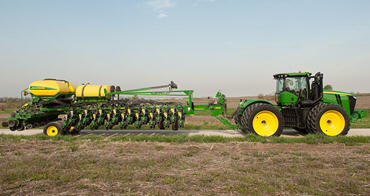
A factory-installed, optional drawbar hitch is available for use with 1775NT 16- and 24-Row, 1775NT Central Commodity System (CCS™) 16- and 24-Row, and 40-ft 1795 Planters. For all DB models the drawbar hitch is in base. All DB models are available with Category 5 drawbar hitch. The following DB models are not available with Category 4 drawbar hitch: DB80 48R20, DB88 48R22, DB90 36R30, DB90 54R20, DB120 48R30.
The planter drawbar hitch provides easy operation with plenty of ground clearance. The hitch design utilizes a hydraulic cylinder to raise the planter hitch for transport. Hydraulic oil for the hitch cylinder, on 1775NTs and 1795s, comes from the row marker system. Activation of this cylinder is accomplished using a single switch on the display and the marker selective control valve (SCV).
Due to the hydraulic system design, the drawbar hitch requires the planter be equipped with independent markers (not tied to planter lift circuit). Removal of markers from all planters, except the 1775NT 24Row30, makes the drawbar hitch inoperable. The 1775NT 24Row30 is the only planter where the drawbar hitch, less markers, is a valid combination.
For planting on 38-cm (15-in.) row spacing with a 16/32-Row 1795 Planter, the drawbar needs to be offset 19-cm (7.5-in.) on the tractor to center the planting rows behind the tractor. When the 16/32 1795 has a drawbar hitch, operators may not be able to offset the hitch to the exact specifications of 19-cm (7.5-in.) when planting in 38-cm (15-in.) operation, and could be off as much as a 1.3-cm (0.5-in.). To compensate, additional adjustments to the marker will be necessary.
When using a guidance system such as parallel tracking or AutoTrac™ assisted steering system, operators will need to use their implement offset when planting with all rows on 1795 Planters equipped with the drawbar hitch to compensate for the offset.
The drawbar hitch is ideal for those who have 9000 Series Tractors without a 3-point hitch. For these, the planter drawbar hitch is the economical choice instead of adding a 3-point hitch.
To accept the planter drawbar hitch, the tractor drawbar must be ordered with, or upgraded to, a Category 4 drawbar with the heavy-duty package or Category 5 to be compatible. Track tractors with wide-swinging drawbars are not compatible with the planter drawbar hitch due to a lower hitch-load capacity.
Each 1795 or 1775NT Planter ordered with the drawbar hitch will be shipped with a Category 4 hitch link installed. A Category 5 hitch link is also shipped with the planter if the planter is to be used with a Category 5 drawbar. See pre-delivery instructions included with the planter for changeover information.
Compatibility:
This hitch also adds 0.6-m (2-ft) to planter length during transport and field operation. There are some combinations of planter options that are not compatible with the drawbar hitch option due to tractor drawbar limitations.
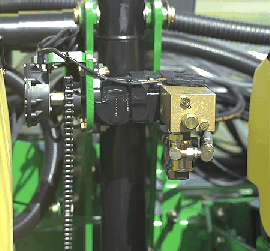 VRD shown on a 1775NT
VRD shown on a 1775NTThe seed variable-rate drive provides the ultimate planting productivity by utilizing one, two or three hydraulic motors (varies by model) to turn the seeding drive shaft. Hydraulic control of the seeding drive allows for on-the-go seeding rate changes right from the display mounted inside the tractor cab.
Combine this seeding flexibility with the map-based planting option, and seeding rates adjust automatically based on a prescription map.
Single- or dual-motor systems for variable-rate drives are available for all John Deere planters except the 1785 Rigid Frame. Dual- or three-motor drive systems are commonly used on larger (12-row and more) planters and offer the capability of half-width or three-section drive disconnect.
The VRD is available as a factory-installed option for all applicable planter models. Single- or dual-motor systems are available as field-installed attachments for most planter models; however, a three-motor VRD field-installed attachment is not available.
The seed VRD requires the SeedStar™ monitor and a radar input signal. Either tractor or planter radar may be used. Planter radar is ordered separately.
VRD offers the following advantages over common, contact-tire drive systems:
The half-width drive disconnect feature is excellent for the producer concerned with controlling seed costs. This feature helps the operator place seed in the desired area and limit the amount of costly overlapped planting.
The half-width drive disconnect allows the operator to turn off half of the planter at a time for planting end rows, point rows, etc. Variable-rate-equipped planters require two drive motors to utilize the half-width disconnect feature.
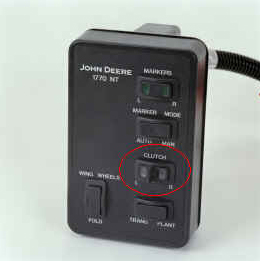 Half-width drive disconnect within frame control
Half-width drive disconnect within frame controlWith a 1765, 1765NT, and 1775 12-Row Planter, a single switch box is required for planters that are ordered with variable rate drive and half-width disconnect.
For the 1775NT, 1775NT Central Commodity System (CCS™), and 1795 Front-Folding Planters, the half-width drive disconnect switch is contained within the frame control box, conveniently located in the tractor cab. The function easily shuts off the drive for the left or right half of the planter row-unit seed meters.
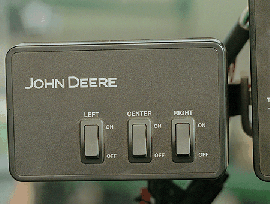 Three-width drive disconnect control
Three-width drive disconnect controlThree-width drive disconnect is an option on 1725 12-Row Planters and is base equipment on the 1725 16Row30 Planter. This feature is activated by three individual console mounted switches (control box), conveniently located in the tractor cab. The function easily shuts off the planter row-unit seed meters by one-, two-, or three-drive segments independently.
SeedStar 4HP is designed to optimize the in-cab monitoring experience exclusively on the Gen 4 4600 CommandCenter™ display or 4640 Universal Display for growers with ExactEmerge™ planters and MaxEmerge™ 5e planters model year 2018 and newer. With SeedStar 4HP, operators will easily see key planter information with customizable run pages, zoom functionality, and simultaneous graph and performance measurements. SeedStar 4HP is included in base on all model year 2018 ExactEmerge and MaxEmerge 5e planters.
Features overview:
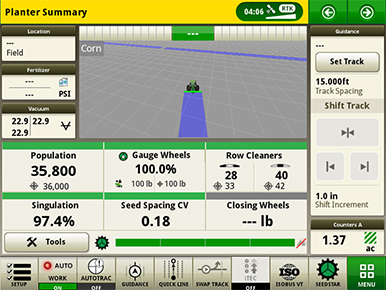 Planter summary default run page
Planter summary default run page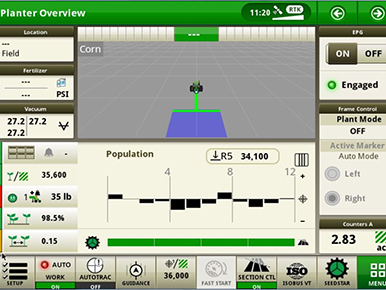 Planter overview default run page
Planter overview default run page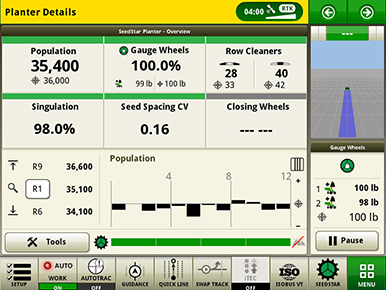 Planter details default run page
Planter details default run pageThree default run pages show key planter functions in different views to give fast and easy access to important planter information.
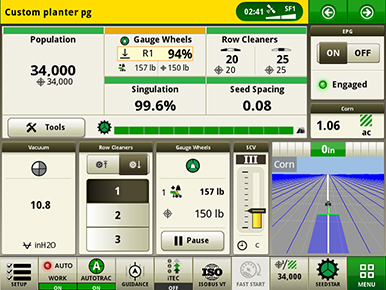 Customizable run pages
Customizable run pagesThere are customizable run pages that allow the operator to build pages that fit their operation with different modules, like the example shown above.
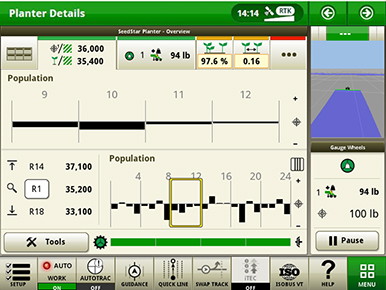 Zoom feature showing a group of rows
Zoom feature showing a group of rows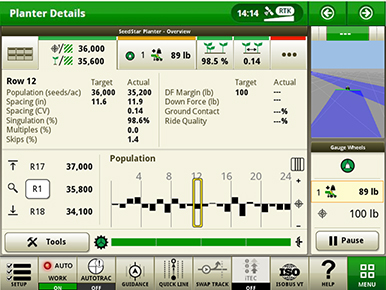 Zoom feature showing a single row
Zoom feature showing a single rowThe zoom feature allows the operator to touch a section or row of the planter and get detailed information quickly.
 Variety set-up page
Variety set-up page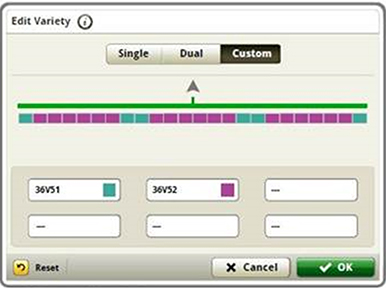 Rate set-up page
Rate set-up page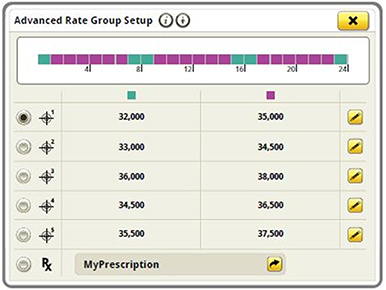 Group rate set-up page
Group rate set-up pageCustom rates allow for individual row population control and row-by-row documentation where up to six different rates can be assigned across an up to 48-row planter. This allows growers interested in planting seed corn with ExactEmerge or MaxEmerge 5e the capability to assign specific populations to male and female rows for planting. This feature can also be used to create tram lines or other applications where custom rates by row are needed.
NOTE: Individual rates are tied to varieties, so each induvial rate needs a unique variety name.
 Dual bar graph showing singulation and population simultaneously
Dual bar graph showing singulation and population simultaneouslyDual bar graphs allow operators to view multiple planter details at one time.
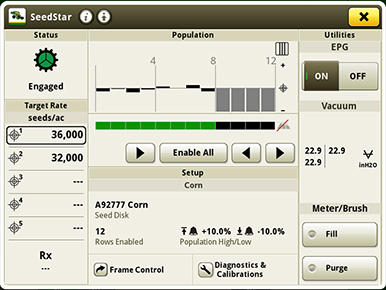 SeedStar application run page
SeedStar application run pageIn the SeedStar application, many adjustments can be made, including manually activating section control. SeedStar 4HP allows up to 48 individual row sections. There are several setup features such as crop, seed disk, number of rows being planted, population alarms, and limits. Seed rates can be modified, electric power generation (EPG) can be turned on or off, vacuum can be adjusted, and the fill and purge functions can be used from the SeedStar application. Frame control, as well as diagnostics and calibrations, can be accessed at the bottom of the screen.
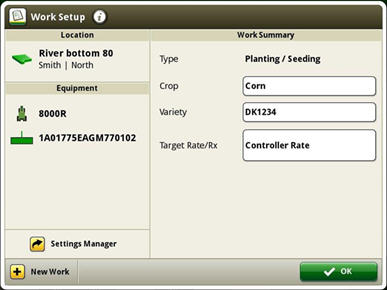 Settings Manager screens
Settings Manager screens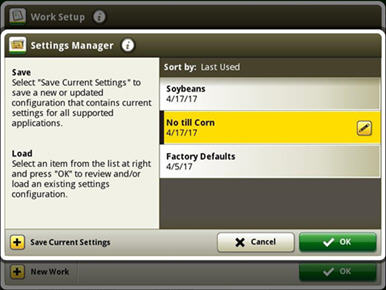
Reduce set up time between changing crops or field conditions by recalling saved settings used previously with Settings Manager, included with every SeedStar 4HP system. This feature allows saving and recalling planter and tractor settings for optimum performance in different conditions.
Settings Manager can be used to save all of the adjustment and inputs associated to a particular crop or condition. An example would be to store all population rates, downforce pressure, row cleaner adjustments, and closing wheel settings for planting corn and storing a separate unique set of adjustments for soybeans. In addition, Settings Manager stores tractor settings such as selective control valve (SCV) flow and detents, infinitely variable transmission (IVT™) settings, eco modes, and more.
| SeedStar 4HP compatibility | |
| Planters | All models ordered with ExactEmerge or MaxEmerge 5e row-units |
| Display | Gen 4 4600 CommandCenter or 4640 Universal Display |
For additional information on feature functionality on the Gen 4 Display, visit the links below:

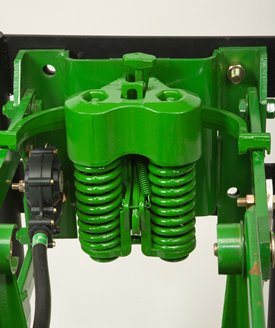 Heavy-duty adjustable downforce spring
Heavy-duty adjustable downforce springPlanter row-unit downforce is an important factor to ensure consistent and proper depth control. The heavy-duty adjustable downforce feature provides up to 181.4 kg (400 lb) of downforce. There are four settings available to allow the operator to choose the amount of downforce required for the condition: 0 kg (0 lb), 56.7 kg (125 lb), 113.4 kg (250 lb), and 181.4 kg (400 lb).
Compatibility: 1705, 1715, 1725, 1735, 1755, 1765, 1765NT, 1775 Flex, and 1785
Pneumatic downforce provides convenient, simple adjustment of downforce for the whole planter from one location. The amount of downforce applied is infinitely adjustable from 0 to 181.4 kg (0 to 400 lb). Pneumatic downforce provides more consistent downforce throughout the range of row-unit travel than mechanical spring downforce systems.
Features include:
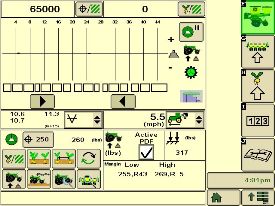 SeedStar XP downforce planter run page
SeedStar XP downforce planter run pageActive downforce control is integrated into SeedStar XP and SeedStar 3HP monitoring systems.
Margin is the amount of weight riding on the depth gauge wheels that ensures desired firming of the seedbed as set by the operator.
Once a target margin has been defined, enter the value into SeedStar XP or SeedStar 3HP and let active downforce do the rest. The system will actively adjust the air pressure in the air bags to maintain a constant margin across the planter. The changes in air pressure will change the amount of downforce placed on the row-unit, compensating and reacting for varying conditions through the field whether it is different tillage practices, soil types, or moisture.
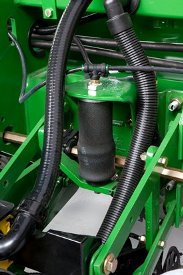 Pneumatic downforce spring
Pneumatic downforce springEach row-unit has a single rubber air bag located between the parallel arms. The air bags are hooked in parallel so that air can be added or released from all rows at once from one location.
The individual pneumatic downforce air bag assemblies, air compressor units, and 9.5-mm (3/8-in.) delivery lines are also available as an attachment for field conversion.
 Pneumatic downforce compressor and gauge
Pneumatic downforce compressor and gaugeAn improved compressor is used to charge the pneumatic system. This compressor can be located on the planter frame or in the tractor cab if desired. A gauge at the compressor indicates the amount of downforce being applied.
From the factory, integral planter models with pneumatic downforce will have an improved air compressor assembly with an in-cab mounting bracket, except for the 1725 16-row and 1725 Central Commodity System (CCS™ ) twin-row planters, which will have the air compressor assembly mounted on the planter frame. For drawn planter models, the 1755, 1765, 1765NT, 1775 Front-Fold, and 1785 Drawn Planters will have the air compressor assembly installed either on the outer hitch or wing frame members when the pneumatic downforce system is installed.
Base equipment on: 1705, 1715, 1725, 1735, 1755, 1765, 1765NT, 1775 and 1785.
The functional features of the integrated system are the same as the standard pneumatic system, explained above, with the addition of control through the GreenStar™ (GS) display.
 Pneumatic downforce control in GS2 Display
Pneumatic downforce control in GS2 Display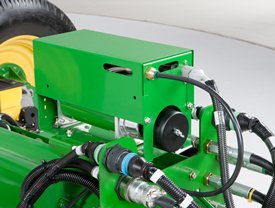 Air compressor mounted on 1775NT outer hitch
Air compressor mounted on 1775NT outer hitchOn 1725 16-row, 1725 Central Commodity System (CCS™) TR, 1775NT, 1775NT CCS, 1795, DR, and DB Series Planter models, the air compressor will be mounted on the outer hitch or frame assembly. Since the air compressor assembly is mounted on the outer hitch (as noted in the picture above) or frame, adjustments for row-unit downforce and related system pressures will be made electronically with the GS display.
When adjusting the amount of row-unit downforce using the GS display, the operator will select the amount of downforce (kg [lb]) to be applied across the planter. Depending on the soil conditions at hand, the operator might need to adjust the relative amount of row-unit downforce being applied during the planting operation. The integrated pneumatic downforce controls within the GS display will only allow for set-point operation and not automatic control as the planter is operating in different soil conditions. The pneumatic downforce system does not have the capability to automatically adjust downforce.
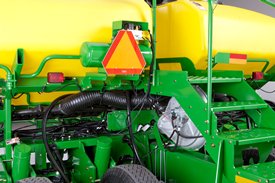 Onboard air storage installed on 1775NT 24R30
Onboard air storage installed on 1775NT 24R30The 1725 16-row, 1725 CCS TR, 1775NT, 1775NT CCS, 1795, DR, and DB Series planters will have onboard air storage to increase the overall response time when making a row-unit down force adjustment from the GS display. The onboard air storage is comprised of a 18.9-L (5-gal.) storage tank with valve assembly.
Base equipment on: 1725 CCS, 1725 16-row, 1725T, 1775NT, 1775NT CCS, 1795, DR, and DB Series Planters with MaxEmerge™ 5 row units. MaxEmerge 5e and ExactEmerge™ equipped planters come with active pneumatic downforce in base.
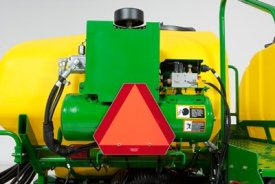 Active downforce compressor assembly
Active downforce compressor assembly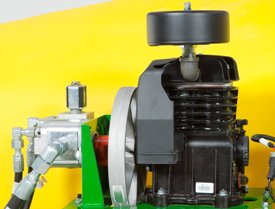 Hydraulic motor
Hydraulic motorA hydraulically driven compressor works with the SeedStar™ 3 HP system and SeedStar XP system to automate downforce control. Just set the row-unit target margin value and the active pneumatic downforce system works automatically. The system will make sure the planter maintains this value, achieving precise soil penetration, and consistent planting depth, without sidewall soil compaction. From the factory, the system is set at 45.4 kg (100 lb) target downforce margin, but may be modified for varying field conditions. This frees the operator from constantly making manual downforce adjustments as conditions change.
This system offers a split-rank control feature for 1795 and DB Split-Row Planters. On split row planters active downforce will control the front and rear rows independently. This compensates for differing downforce requirements between the ranks that can be caused by things like different tillage or insecticide attachments and will help maintain an accurate planting depth and consistent margin across all the rows.
Active pneumatic downforce is available as factory installed or as an attachment for field conversion.
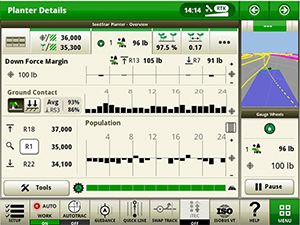 IRHD screen showing the ground contact graph
IRHD screen showing the ground contact graph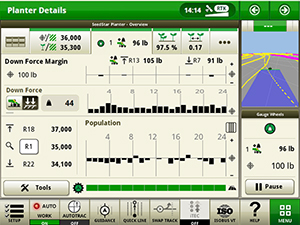 IRHD screen showing the applied downforce graph
IRHD screen showing the applied downforce graphOptional equipment on: 1775NT, 1795 and DB models with MaxEmerge™ 5e and ExactEmerge™ row units.
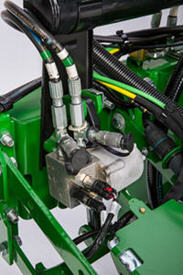
IRHD has been specifically designed to meet the needs of producers that are looking to adjust to the toughest field conditions and provide maximum yield potential from field to field, season after season. IRHD works as a closed-loop downforce system that reacts quickly on an individual row basis to changing soil conditions supporting increased ground contact, which can lead to improved seed depth consistency. When setting planter downforce margin, the system will apply the needed downforce by row to maintain ground contact. From the factory, the margin will be set at 45.4 kg (100 lb), changes may be required based on varying field conditions.
The system allows operators to maintain gauge wheel ground contact leading to desired seed depth placement. IRHD can adjust five times per second and make adjustments of 45.4 kg (100 lb) in less than a second. The system has a total range of applied downforce from 22.7 kg (50 lb) to 204.1 kg (450 lb) and utilizes the power beyond circuit on the tractor. IRHD is 58 percent faster than the active pneumatic downforce solution. Fast reaction and increased ground contact can lead to improved emergence. With uniform emergence, some studies have shown a yield impact from 5 percent to 9 percent.
IRHD is controlled through the Gen 4 4600 CommandCenter™ display or 4640 Universal Display with SeedStar 4HP. As shown below, operators can view ground contact or applied downforce using the toggle button.
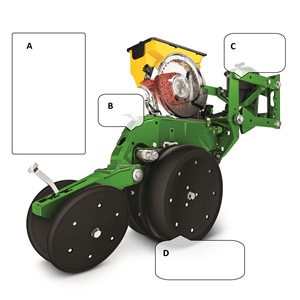 Down force and margin example
Down force and margin example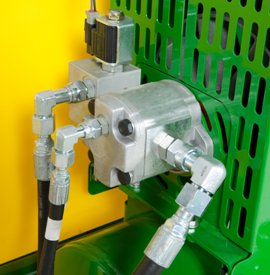 Hydraulic motor
Hydraulic motor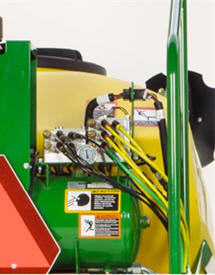 Pneumatic valve
Pneumatic valveThe hydraulically-driven air compressor can deliver up to eight times the air flow, allowing for more and faster downforce changes to be made. This more robust design features a 37.8-L (10-gal.) storage tank across all models with active downforce.
At approximately 15.1 L/min (4 gpm), hydraulic demands are low and ties into the machine’s lift and CCS hydraulic circuit so it does not require any additional selective control valves (SCVs). The SeedStar XP and SeedStar 3HP monitoring systems work with the compressor and valve assembly to regulate air to downforce springs, enabling the active control.
Another feature of John Deere active downforce is the ability for the pneumatic valve to independently control split-rank machines. This system senses the downforce needs from the front and rear ranks separately and independently adjusts air pressures with the dual-rank pneumatic valve when equipped. Active pneumatic downforce requires SeedStar XP or SeedStar 3HP to enable active control.
Base equipment on: All MaxEmerge™ 5e and ExactEmerge™ equipped planter models.
The CIS is designed to work with Force® CS system, which is an improved soil-applied insecticide designed to deliver consistent performance in an advanced, convenient liquid formulation.
The innovative design of the CIS incorporates many user-friendly features such as closed handling, central fill, direct injection, and industry-leading row-to-row accuracy. CIS is available on the following models with Central Commodity System (CCS™) equipped planters, and can be only ordered as an aftermarket field conversion attachment:
For more than 20 years, growers have trusted the performance of Force 3G for superior control of corn rootworms, as well as troublesome early-season pests. Now, with Force CS, growers can achieve the same top-rated performance they have come to expect from Force 3G in an easier to use liquid formulation. Force CS will be packaged in a unique patent-pending box. Each box contains 9.4 L (2.5 gal.) of Force CS and will treat approximately 16 ha (440 acres).
The CIS consists of six major components:
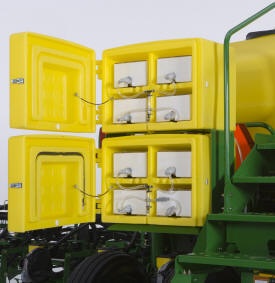 Insecticide cabinet - loaded with Force CS
Insecticide cabinet - loaded with Force CSThe insecticide cabinet, which is manufactured from the same material as the CCS tanks, is designed to hold a maximum of eight boxes of Force CS. Each Force CS box contains 9.4 L (2.5 gal.) of product for a total system capacity of 76 L (20 gal). This 76 L (20 gal.) of Force CS allows the operator to cover 256 acres between fills if the full rate (10 oz/acre for 76-cm [30-in.] rows) of Force CS is applied for all rows. The coverage acres increase if product is only applied to the designated refuge rows.
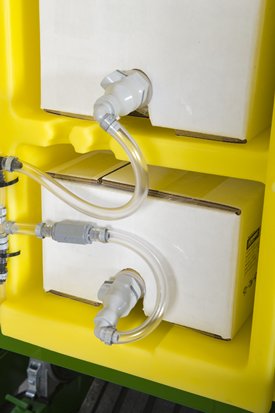 Connectors and in-line check valve
Connectors and in-line check valveAfter the desired number of Force CS boxes are placed in the cabinet, the operator connects the Force CS box to the CIS system by using a connector (shown on the left). This connection device drastically reduces the amount of exposure compared to granular-type insecticide systems.
The system is also designed to empty the boxes from the top down. Product from the top boxes will empty before the system starts to pull product from the next row. This is possible by utilizing a check valve on the last product box (shown on the left).
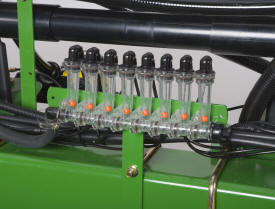 Flow monitors
Flow monitorsFlow monitors are mounted on the wings to provide operator confidence and peace of mind that each row is receiving an equal amount of product. When operating, the orange balls within the flow monitors will be suspended in the middle of the site glass. If a nozzle or delivery line becomes restricted or becomes damaged, the flow monitor will indicate this under or over application.
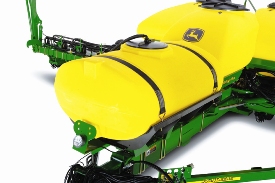 1135.6-L (300-gal.) tank on 1775NT 16Row
1135.6-L (300-gal.) tank on 1775NT 16RowThe CIS utilizes direct injection technology to move ounces of the Force CS product into water; therefore, every CIS requires an appropriately sized water tank to supply the pump and valve assembly for Force CS application. Below is a chart with planter model, tank sizes, and acres covered.
Planter model | Water capacity | Acres/fill (water) | Acres/fill (insecticide) eight-box cabinet |
Rate = 2 gal./acre | Rate = 10 oz/acre | ||
| 9.1-m (30-ft) 1795 | 852 L (225 gal.) | 46 ha (113 acres) | 104 ha (256 acres) |
| 12.2-m (40-ft) 1795 | 1060 L (280 gal.) | 57 ha (140 acres) | 104 ha (256 acres) |
12-row 1775NT CCS | 852 L (225 gal.) | 46 ha (113 acres) | 104 ha (256 acres) |
16-row 1775NT CCS | 1136 L (300 gal.) | 61 ha (150 acres) | 104 ha (256 acres) |
24-row 1775NT CCS | 1703 L (450 gal.) | 91 ha (225 acres) | 104 ha (256 acres) |
DB60 | 1590 L (420 gal.) | 85 ha (210 acres) | 104 ha (256 acres) |
DB80 | 1590 L (420 gal.) | 85 ha (210 acres) | 104 ha (256 acres) |
DB90 | 1590 L (420 gal.) | 85 ha (210 acres) | 104 ha (256 acres) |
NOTE: Depending on model, water capacities may be reduced when equipped with Refuge Plus™ system.
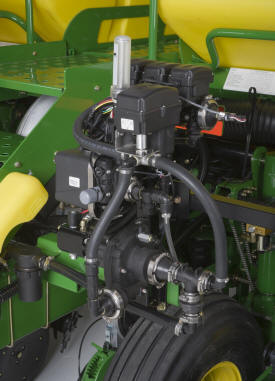 Pump and valve assembly
Pump and valve assembly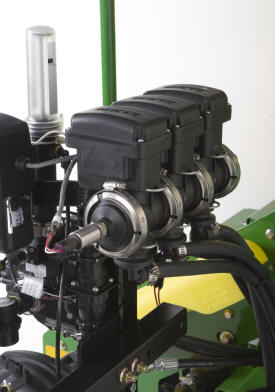 Three-section valves
Three-section valvesThe pump and valve assembly consists of a hydraulically driven water pump, electric injection pump, and section valves. The hydraulic water pump is tied into the frame hydraulics and does not require an additional selective control valve (SCV). The electric injection pump pulls product out of the Force CS boxes and injects the product into the waterline, which then enters a mixing chamber where the water and Force CS are thoroughly mixed together.
The CIS system features a closed calibration procedure to protect the operator from insecticide exposure. Comparable granular type insecticide systems require the operator to collect chemical from each row-unit on the planter, while the CIS closed calibration is performed at one central location and does not require the operator to measure any product, dramatically eliminating exposure to insecticide.
One of the many features of the CIS is the ability to apply insecticide on refuge rows only. From the tractor cab, the operator can set the monitor to apply insecticide to refuge rows only. This makes the CIS a perfect fit with Refuge Plus. When refuge only is selected on the monitor, the CIS will only apply insecticide on the designated refuge rows. These rows are predetermined from the factory and are listed below for each model.
| Model | Refuge rows |
1775NT CCS - 12row | 10, 11, 12 |
| 1775NT CCS - 16row | 13, 14, 15, 16 |
| 1775NT CCS - 24row | 20, 21, 22, 23, 24 |
| 1795 - 12/23row | 19, 21, 23 |
| 1795 - 12/24row | 20, 22, 24 |
| 1795 - 16/31row | 25, 27, 29, 31 |
| 1795 - 16/32row | 26, 28, 30, 32 |
| DB 60 | 20, 21, 22, 23, 24 |
| DB 80 | 14, 15, 16, 17, 18, 19, 20 |
| DB 90 | 15, 16, 17, 18, 19, 20, 21, 22 |
While the ability to apply Force CS to refuge rows is a unique feature, CIS can easily distribute product to every row across the entire planter width. Application setup is simple and is completed through the system monitor/controller.
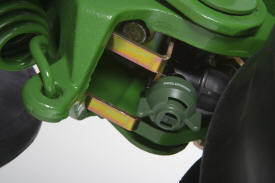 Nozzle
NozzleThe CIS system utilizes a 0067 SprayMasterTM nozzle to apply the Force CS in 13- to 20-cm (5- to 8-in.) T-band over the seed furrow. This nozzle is located between the double disk openers and the closing wheels. When not in use, a nozzle cap is provided to replace the nozzle protecting it from wear.
Applying Force CS in a T-band pattern is the only approved application method. Spraying the product in a T-band ensures proper application and seed/soil coverage. The supplied 0067 SprayMaster nozzle is not compatible with any length of aftermarket seed firmer due to spray interference. If the planter is equipped with short seed firmer, a separate flat fan nozzle and adapter should be used.
 CIS monitor
CIS monitorCIS utilizes a separate, independent monitor that also acts as the system controller. The monitor is capable of controlling two separate products at the same time (water and Force CS) and is compatible with GreenStar™ (GS) 2 Field Doc™ connect. This monitor is specific to the CIS and will not work with any other applications.
The monitor conveniently displays product application rates, acre totals, and product/acres remaining. System setup, product and water rates, as well as priming are initiated from the controller/monitor. CIS is completely integrated with the planter design. CIS automatically shuts off product flow when the planter is raised and is also tied to the seed meter one-half or one-third width disconnect.
IMPORTANT: Always read and follow label directions before buying or using this product. Force CS is a restricted-use pesticide.
Force® CS is a trademark of a Syngenta Group Company.
CIS end-of-season cleanout and winterization is simple to perform. CIS will draw John Deere winterizer fluid (part N305643 or equivalent) through the system and residual Force CS with winterizing fluid solution will be captured in an enclosed container for proper disposal. Follow all label instructions for proper handling and disposal procedures.

Easy fold is a new feature of SeedStar™ 4HP for MaxEmerge™ 5e Planters and ExactEmerge™ Planters equipped 1775NT and 1795 with 2-point hitch, DB60 24R30, DB60 36R20, DB60 47R15, DB60 48R15 Planters. This integrated solution replaces the frame-folding box like the manual fold option in SeedStar 3HP, and it has enhanced the process by controlling and automating the selective control valves (SCVs).
The one-operation fold reduces the need for training inexperienced operators by sequencing the process correctly and reduces time spent folding and unfolding. By utilizing implement automation, the hitch will be controlled by the planter during the fold cycle. Lining up the draft tube to the wing hooks is automated through this process reducing the operator tasks. On DB models, easy fold simplifies the folding process functions to one SCV. A manual process is available when needed.
A manual fold option is available from the frame control page on the display for non-compatible or non-equipped tractors or planters. The manual control function is accessible from each step of the easy fold process, as shown below.
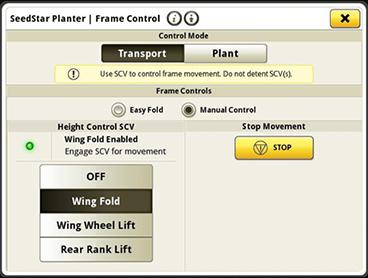 Manual control option on SeedStar 4HP
Manual control option on SeedStar 4HP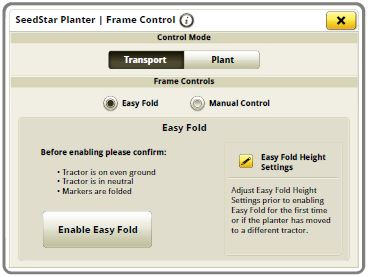 Start screen for easy fold
Start screen for easy fold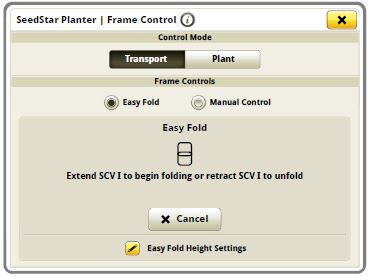 Screen with easy fold enabled
Screen with easy fold enabled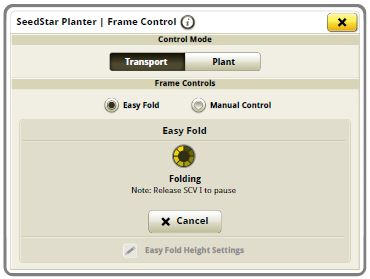 Screen with easy fold in process
Screen with easy fold in process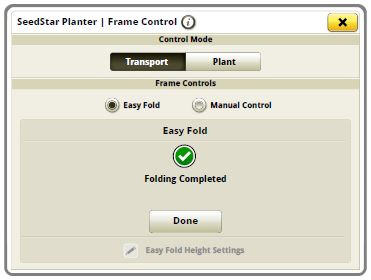 Easy fold completed screen
Easy fold completed screen| Easy fold compatibility | |
| Tractors |
|
| Activation | 2-point hitch equipped planters with easy fold require tractor implement automation activation available from StellarSupport. This activation is tractor PIN specific and no-transferable. Included in base on model year 2018 compatible tractors. |
| Planters | 1775NT and 1795 with 2-point hitch, DB60 24R30, DB60 36R20, DB60 47R15, DB60 48R15 equipped with ExactEmerge or MaxEmerge 5e row-units |
| Display | Gen 4 4600 CommandCenter™ or 4640 Universal Display |
Crop yields have increased through the years along with the amount of residue left in the field after harvest. At the same time, tillage practices have changed, including different tillage operations which maintain large amounts of surface residue, and even no till practices. Row cleaners are an essential tool in managing this increased amount of residue.
John Deere seeding group offers a variety of row cleaner options to meet the needs of a producer's operation. Compatibility varies by model, row spacing, and other planter equipment.
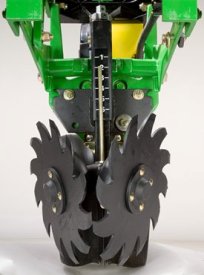 Screw-adjust unit-mounted row cleaner
Screw-adjust unit-mounted row cleanerThe screw-adjust unit-mounted row cleaner is mounted directly to the face plate of the row-unit, placing the ground engaging components just in front of the row-unit opener blades and depth gauge wheels. This close proximity allows the gauge wheels to control the depth of the row cleaner as well as the row-unit. This compact design also allows greater compatibility with fertilizer openers and other planter attachments.
SharkTooth® wheels are standard equipment on the unit-mounted row cleaner. The swept-tooth design of the wheel provides a clear path for the row-unit openers while resisting residue buildup on the wheel. The screw adjustment knob is accessible through the top of the parallel arms, providing convenient access for adjustments. The row cleaner can be adjusted in 1.6-mm (0.06-in.) increments, providing plenty of flexibility to meet the needs of changing conditions.
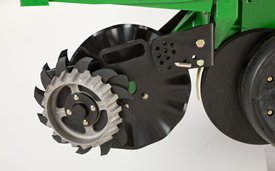 Floating row cleaner with unit-mounted coulter
Floating row cleaner with unit-mounted coulterThe floating row cleaner allows a row cleaner to be used in conjunction with a unit-mounted coulter. This combination is often desired in heavy residue loads and tough reduced tillage planting conditions. The row cleaner provides a clear path for the row-unit, while the unit-mounted coulter helps penetrate tough soil conditions.
Accommodating the unit-mounted coulter means the residue wheels are farther forward from the row-unit face plate than in the case of the screw adjust row cleaner. To maintain performance, this row cleaner has the capability to float above a defined minimum depth.
Standard depth-gauging bands on the wheels allow the row cleaner wheels to float independently of the row unit openers, allowing both to perform in varying terrain. The unit may also be set in a fixed position by simply pinning through the bracket if desired. This row cleaner also features SharkTooth wheels as standard equipment.
The floating row cleaner and unit-mounted coulters are available on many planters as factory-installed equipment. As compatibility and details vary by model, review the following links for information on specific planter models.
SharkTooth is a trademark of Yetter Manufacturing.
NOTE: Screw-adjust row cleaners are not compatible with MaxEmerge™ 5e row-units with long parallel arms.
NOTE: DB models have the option for either unit-mounted coulter, screw-adjust row cleaners, or pneumatic row cleaners (only compatabile with MaxEmerge 5e or equipped ExactEmerge™ models). The DB60T is only available with less row cleaner option.
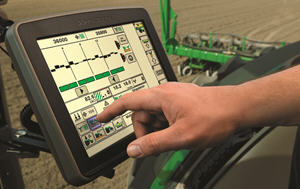 SeedStar XP shown on the GreenStar 3 2630 Display
SeedStar XP shown on the GreenStar 3 2630 Display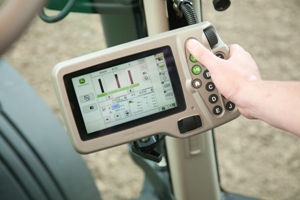 SeedStar XP shown on the GreenStar 2 1800 Display
SeedStar XP shown on the GreenStar 2 1800 DisplayBuilding upon the foundation of SeedStar 2, the SeedStar XP system takes planter monitoring to the next level. When paired with the GreenStar™ (GS) displays (GS 2600 or 2630 Display or the entry-level GS2 1800 Display), the SeedStar XP monitoring system provides more information about the planting process to the operator within the tractor cab.
Specific information about how the planter is performing enables the operator to make needed adjustments for implement optimization.
The SeedStar XP planting functions are fully integrated with the full spectrum of AMS applications such as Swath Control Pro™ system for planters, GreenStar AutoTrac™ assisted steering system, John Deere Operations Center, documentation, and others. Integrated planting technologies, for better asset utilization and ease of use, is just part of what SeedStar XP provides.
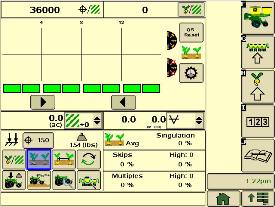 SeedStar XP seed singulation planter run page
SeedStar XP seed singulation planter run pageUnderstanding the meter singulation performance on the planter is critical to minimizing the amount of seed multiples and skips. As a result, the SeedStar XP monitoring system provides real-time information from the row-units about the overall seed singulation performance.
As seen in the screen shot image above, seed multiple information is displayed on the top portion of the planter-at-a-glance bar with seed skip information on the lower portion. This provides the operator a better understanding of relative seed multiple and skip data on a row-unit basis; all within one easy glance.
Also, within the seed singulation planter run page, information about row-units with the highest percentage of seed multiples and skips is provided in order to make necessary adjustments for better planter optimization.
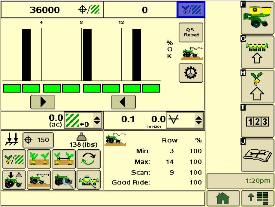 SeedStar XP ride dynamics planter run page
SeedStar XP ride dynamics planter run pageWhile operating a planter, travel speed and field conditions can affect the amount of row-unit bounce that is experienced. Excessive row-unit bounce or vertical motion can cause problems with meter performance. To better understand the amount of row-unit vertical motion when travelling through a field, the SeedStar XP monitoring system provides real-time information on row-unit ride dynamics.
As seen in the ride dynamics planter-at-a-glance screen shot image above, the SeedStar XP system provides ride dynamic information for each sensor node that is mounted on the planter. Each sensor node transmits ride dynamic information for each planter frame section to allow for the operator to make necessary operating adjustments to improve overall planting performance.
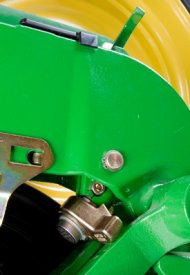 Downforce sensor installed
Downforce sensor installed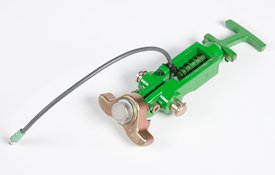 Downforce sensor assembly
Downforce sensor assemblyDepending on the planter size, different configurations of sensor nodes and downforce sensors are installed in support of the SeedStar XP monitoring system.
 SeedStar XP downforce planter run page
SeedStar XP downforce planter run pageAs row-unit downforce systems gradually change from heavy-duty downforce springs to pneumatic downforce, being able to understand the amount of as-applied row-unit downforce is needed while operating the planter.
With various soil conditions, moisture, etc. experienced while planting, it is imperative to have the ability to change actual row-unit downforce to have enough force for the Tru-Vee™ openers to penetrate the soil media. However, in some conditions, having too much downforce applied to the row-units for effective opener penetration could cause problems with side wall compaction from the gauge wheel.
Side wall compaction within the seed furrow can cause hatchet roots to develop; or roots that do not have the ability to penetrate the seed furrow soil media. This could lead to poor plant emergence and eventually lower overall yield performance.
With the SeedStar XP monitoring system, row-unit downforce information is measured by the downforce sensor and sensor nodes and transmitted to the GreenStar 2 (GS2) Display in the tractor cab (as seen in the image above). The row-unit downforce information is displayed on the top portion of the planter-at-a-glance bar with more row-unit downforce information on the lower portion.
Two different control options are available on 1775NT, 1795, and DB Series Planters for pneumatic downforce. The base pneumatic downforce system requires manual control of the downforce to maintain the desired planting results or row-unit margin. Optional active pneumatic downforce takes SeedStar XP even further by removing constant downforce adjustments from the operator and actively controlling the downforce system to maintain a desired target margin.
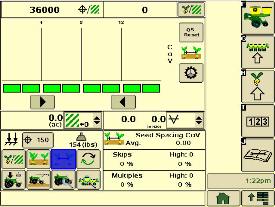 SeedStar XP seed spacing planter run page
SeedStar XP seed spacing planter run pageThroughout the planting process, obtaining good seed spacing is critical toward achieving plant growing conditions for maximum yield potential.
Today, many items are adjusted on the planter prior to planting to optimize overall seed spacing performance. After such adjustments are made, information about the actual seed spacing performance during planting was missing within the planter monitoring system. Now with SeedStar XP, seed spacing information is transmitted live via the GreenStar display to show the operator exactly what is happening with the planter behind them.
The SeedStar XP transmits seed spacing information onto the planter-at-a-glance bar for easy understanding of planter seed spacing performance. Also, information about seed skips and multiples is provided to help understand actual planter meter performance and other related system functions in order to make necessary adjustments if needed.
NOTE: Seed spacing and seed singulation information is only available when planting crops with seed drop rates below 40 seeds/second such as corn. With higher population crops such as soybeans the system does not provide spacing and singulation information because the number of seeds dropping per second is much higher.
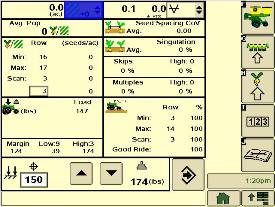 SeedStar XP planter details
SeedStar XP planter details With the capability of monitoring differences in planting performance items such as seed singulation and row-unit downforce, having one screen to view all planter performance elements is needed to understand the whole planting system. SeedStar XP combines all of the various planting performance elements into one full-color, planter overview screen to enable for a quick understanding of relative planting functionality.
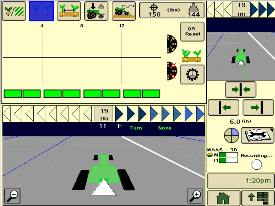 SeedStar XP seed singulation half screen
SeedStar XP seed singulation half screen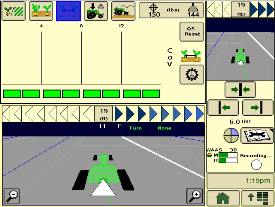 SeedStar XP seed spacing half screen
SeedStar XP seed spacing half screenOther SeedStar XP monitoring features include:
SeedStar XP retains all of those SeedStar 2 features that producers value and have come to expect:
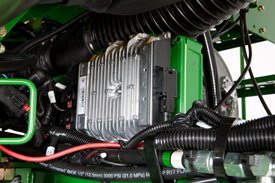 Planter main 2 controller
Planter main 2 controller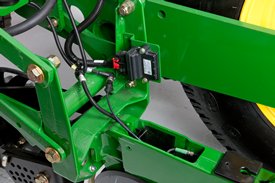 Sensor node assembly installed
Sensor node assembly installedThe SeedStar XP monitoring system contains the following components in order to support the planting data transfer to the GS2 Displays:
The planter main 2 controller processes the row-unit data from the sensor node assemblies located on the row-unit head casting. The processed information is then sent to the SMVR controller to be integrated into the displayed information being sent to the GS Display.
Downforce sensor assemblies are found on row-units with sensor nodes installed. The downforce sensor assembly is assembled with the gauge wheel depth-adjustment handle and provides gauge wheel pressure information to the respective sensor node for data processing.
© COPYRIGHT 2024 LEGACY EQUIPMENT - ALL RIGHTS RESERVED| Privacy Policy | Powered By